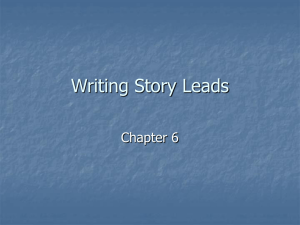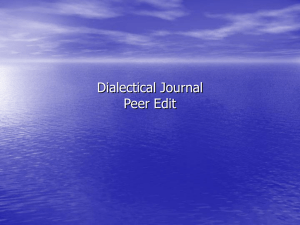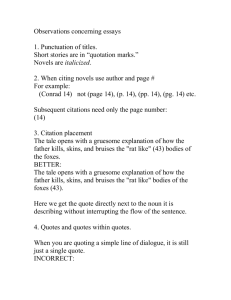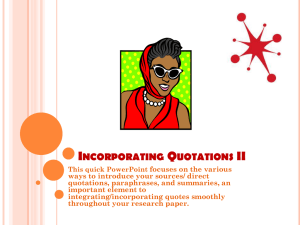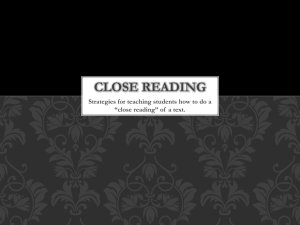Textual Evidence - Highline Public Schools
advertisement
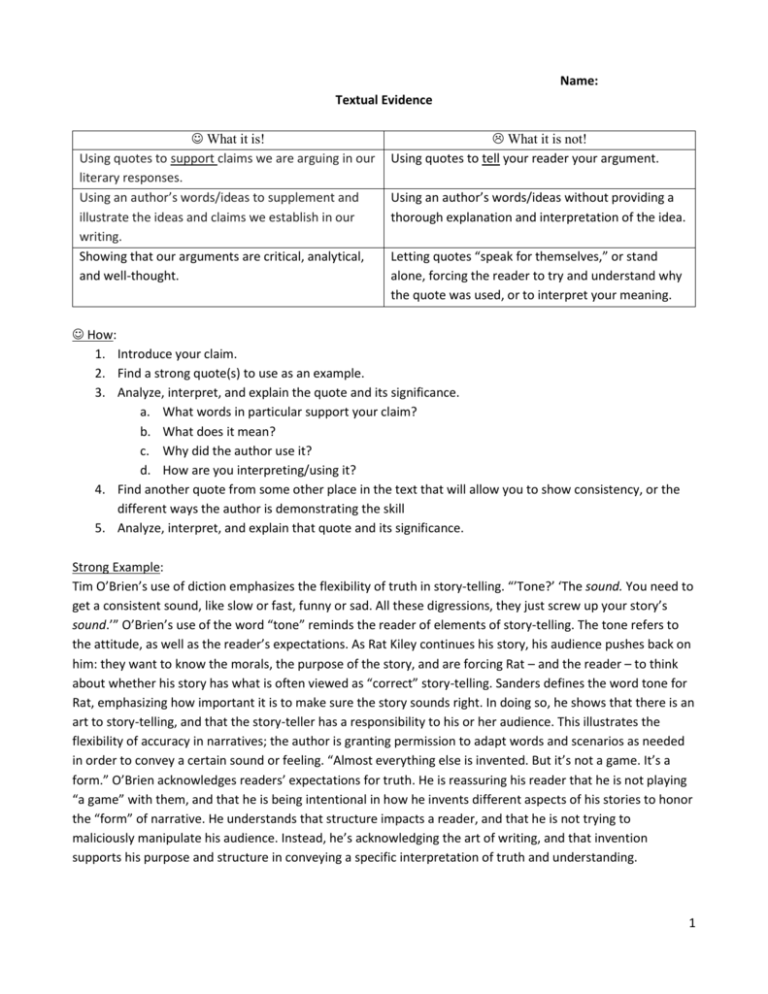
Name: Textual Evidence What it is! Using quotes to support claims we are arguing in our literary responses. Using an author’s words/ideas to supplement and illustrate the ideas and claims we establish in our writing. Showing that our arguments are critical, analytical, and well-thought. What it is not! Using quotes to tell your reader your argument. Using an author’s words/ideas without providing a thorough explanation and interpretation of the idea. Letting quotes “speak for themselves,” or stand alone, forcing the reader to try and understand why the quote was used, or to interpret your meaning. How: 1. Introduce your claim. 2. Find a strong quote(s) to use as an example. 3. Analyze, interpret, and explain the quote and its significance. a. What words in particular support your claim? b. What does it mean? c. Why did the author use it? d. How are you interpreting/using it? 4. Find another quote from some other place in the text that will allow you to show consistency, or the different ways the author is demonstrating the skill 5. Analyze, interpret, and explain that quote and its significance. Strong Example: Tim O’Brien’s use of diction emphasizes the flexibility of truth in story-telling. “’Tone?’ ‘The sound. You need to get a consistent sound, like slow or fast, funny or sad. All these digressions, they just screw up your story’s sound.’” O’Brien’s use of the word “tone” reminds the reader of elements of story-telling. The tone refers to the attitude, as well as the reader’s expectations. As Rat Kiley continues his story, his audience pushes back on him: they want to know the morals, the purpose of the story, and are forcing Rat – and the reader – to think about whether his story has what is often viewed as “correct” story-telling. Sanders defines the word tone for Rat, emphasizing how important it is to make sure the story sounds right. In doing so, he shows that there is an art to story-telling, and that the story-teller has a responsibility to his or her audience. This illustrates the flexibility of accuracy in narratives; the author is granting permission to adapt words and scenarios as needed in order to convey a certain sound or feeling. “Almost everything else is invented. But it’s not a game. It’s a form.” O’Brien acknowledges readers’ expectations for truth. He is reassuring his reader that he is not playing “a game” with them, and that he is being intentional in how he invents different aspects of his stories to honor the “form” of narrative. He understands that structure impacts a reader, and that he is not trying to maliciously manipulate his audience. Instead, he’s acknowledging the art of writing, and that invention supports his purpose and structure in conveying a specific interpretation of truth and understanding. 1 Not How: 1. Introduce a literary technique that is used. 2. Find a quote (or quotes) as an example. 3. Ignore the interpretation, reason, purpose, or use of the quote; make a shallow comment that says that this is an example, but not how/why. 4. Use another quote. 5. Once again, ignore the interpretation, etc. Weak Example: Tim O’Brien uses diction. “’Tone?’ ‘The sound. You need to get a consistent sound, like slow or fast, funny or sad. All these digressions, they just screw up your story’s sound.’” This shows that O’Brien uses diction to explore truth. “Almost everything else is invented. But it’s not a game. It’s a form.” These two examples show that diction is important in finding the truth. How to cite textual evidence 1. Choose your quote wisely – shorter tends to be better! - If it’s really long, either cut out words and replace with an ellipses (. . .), or break it down into multiple examples 2. Format it: - Use quotation marks - If you’re quoting dialogue, the dialogue should be enclosed with a single quotation mark: “’Hello,’ he said.” 3. If the quote you are using is more than four lines typed, it needs to be formatted as a block quote: this means it will be a single-spaced, indented paragraph. Block quotes do not use quotation marks. Commentary before and after the block quote follows the standard margins. Example: Tim O’Brien’s use of syntax allows the reader to take on the physical and emotional burdens of his characters by lengthening sentences and creating exhaustive lists. On ambush, or other night missions, they carried peculiar little odds and ends. Kiowa always took along his New Testament and a pair of moccasins for silence. Dave Jensen carried night-sight vitamins high in carotene. Lee Strunk carried his slingshot; ammo, he claimed, would never be a problem. Rat Kiley carried brandy and M&M's candy. Until he was shot, Ted Lavender carried the starlight scope, which weighed 6.3 pounds with its aluminum carrying case. Henry Dobbins carried his girlfriend's pantyhose wrapped around his neck as a comforter. They all carried ghosts. O’Brien varies the length of his sentences in this passage as a way of creating a reaction in his readers. This is obvious at the end, when he changes his syntax by including the short phrase, “They all carried ghosts.” The abrupt structure demands the reader’s attention, ensuring that this vital point is driven home. 4. Cite the page number. Although other formatting styles (APA, Turabian, etc.) require different ways of citing the page number in-text, all that MLA asks for is the author’s last name and page number. 2 - In literary responses, where you’re only referencing one author’s work, you can simply introduce the author at the beginning of the paper, and then cite the page numbers. To cite pages, you only need to use the page the quote begins on. You do not need to write “page” or “pg.” The page number goes inside of parenthesis, immediately following the closed quotation mark. End punctuation goes after the closed parenthesis. Example: In Tim O’Brien’s novel The Things They Carried, O’Brien explores the notion of truth. He does so using diction. In the chapter “How to Tell a True War Story,” the author addresses it by using the word repeatedly. “This is true” (38). 3


